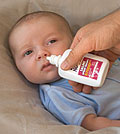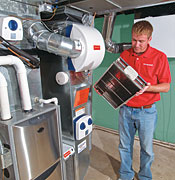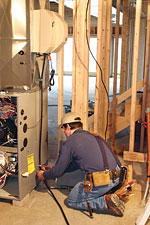
That's not to say that IAQ equipment isn't crucial for a portion of the population; for example, those who suffer from severe allergies or asthma definitely see its benefits on a daily basis. For others, though, ultraviolet (UV) lights, HEPA filters, and humidifiers are often viewed as nice accessories to have if they can afford them after replacing their furnaces or air conditioners.
That attitude can make it a difficult sell for contractors; however, many manufacturers are doing their best to educate homeowners about the consequences of indoor pollutants through extensive advertising on TV, radio, and in magazines.
Now that the IAQ ball is rolling, it's up to the contractor to make sure homeowners know about the various products that are available to remove indoor pollutants from their homes - no matter what the cost.

CLEARING THE AIR
According to the U.S. Environmental Protection Agency (EPA), indoor pollution sources that release gases or particles into the air are the primary cause of IAQ problems in homes. Inadequate ventilation can increase indoor pollutant levels by not bringing in enough outdoor air to dilute emissions, and by not carrying indoor air pollutants out of the home. High temperature and humidity levels can also increase concentrations of some pollutants.Charles H. Martin III, CIE, IAQ department manager, Woodfin Heating, Mechanicsville, Va., spends his days talking with customers about these issues and offering solutions that can improve the IAQ in their homes.
He said that you never know which customer is going to purchase IAQ equipment; however, it is true that many IAQ solutions and products are fairly expensive, which means it is often the wealthier homeowners who can afford to buy them.
"We try to offer what we think is the best, and unfortunately, only some of the most affluent people can afford the best, even though many without such means really need it too," said Martin.
"But there's no rhyme or reason as to who is going to buy and at what level. A lot of it comes down to whoever understands their personal needs best; then they'll go ahead and spend the extra money to get the best system for them."
DEFINING IAQ
Just what is the best IAQ system? The key considerations are control of temperature, humidity, particulates, and ventilation air. Each of these elements leads to specific products; together they can deliver the ultimate in comfort, health, energy savings, and protection and/or preservation of the home and its furnishings.For one of Martin's more well-off customers in the Richmond, Va. area, the best IAQ solution involved sealing the damp crawl space, cleaning and sealing the ducts (which were full of sheetrock dust), installing a Lennox Pure Air purification system, shining a germicidal UV light on the indoor coil, and installing a fresh air dehumidification system.
The grand total came to around $8,000, which is a figure most homeowners don't want to hear for a whole new heating or air conditioning system, much less the accessories.
"That's why many customers choose to install IAQ equipment in stages," said Martin.
"They'll start by having their ducts cleaned and hopefully installing a higher MERV level filter. After that, they'll get their ducts sealed and renovated when they can afford it. The average improvement is usually in the $1,000-$3,000 range, which is why it may take several years before they have a complete IAQ solution."
For Dan Joyce, director of trade channel marketing, Honeywell N.A. Homes, the premier IAQ system is the one he had installed in his own home. It consists of a variable-speed, high-efficiency system, which addresses the airflow needed for IAQ as well as energy efficiency. UV lights zap airborne germs and bacteria, while a powered filtration system traps any other particulates. A dehumidifier controls moisture during summer months, and a central humidifier adds moisture during the dry winter months.
Zoning provides comfort and energy savings, and a whole-house heat/energy recovery ventilator (HRV or ERV) helps provide proper ventilation. The entire system is controlled from an integrated central control that provides convenience and energy efficiency.
"I also monitor and protect my system with a CO detector by the furnace or air handler, both for safety and to meet many local and state codes," said Joyce.
"And I have an AirAdvice monitor in my home that monitors air quality on an ongoing basis and allows me the opportunity to view graphs of my home's climate."
As you might imagine, this type of comprehensive IAQ system is not inexpensive. Joyce estimated it could cost $5,000-$25,000, depending on the size of the home, the application, and level of system. Homeowners investing in such extensive systems do require more disposable income, said Joyce. However, some less expensive options can go a long way toward improving a customer's IAQ

NOT JUST FOR THE RICH
According to Tom Rodgers, marketing, Aprilaire, contractors often believe that IAQ equipment is only for the affluent, but that is an incorrect assumption."Even average families deserve, want, or may need an IAQ product to be comfortable in their home, for health reasons or because their home or furnishings require it."
Rodgers added that his company has done market research that shows consumer awareness of whole-home IAQ products is near zero.
"If a contractor chooses not to offer it, there is no way to have a discussion about the homeowners' needs and/or wants, or for the homeowner to say yes," said Rodgers.
There are also many options available to finance IAQ products, noted Rodgers, including leveraging a home's equity, which can result in a small monthly payment as well as tax benefits for the homeowner. "With the rising value of homes, financing is an option that makes IAQ affordable for the masses," noted Rodgers.
Another factor to consider in consumer economics, said Rodgers, is the cost to purchase, operate, and maintain portable IAQ products. "With over 5 million portable air cleaners, over 5 million portable humidifiers, and over 1 million portable dehumidifiers sold per year, there is a lot of maintenance, parts, electricity, etc., that would go away with whole-home IAQ products," said Rodgers.

PRODUCT OFFERINGS
One of those whole-home IAQ products is a humidity-control device, such as an automatic humidifier or whole-house dehumidifier. It is often said that humidity control drives comfort more than temperature control: Too dry and moisture evaporates from the skin, making the occupant feel cold; too humid and the occupant feels sticky.When proper winter humidity levels are obtained in a home, Rodgers said, homeowners can lower their temperature settings 3° to 4°F, which is a big deal with today's escalating energy costs. "It's also been shown that proper humidity levels improve health," he said.
"Even in today's tight homes, a humidifier is still needed due to the increased outdoor air ventilation requirements."
An air cleaner is another whole-house IAQ product that is useful in controlling particulates such as dust, dirt, and other airborne contaminants. The key to an air cleaner is year-round performance, which is best obtained with a variable-speed system.
"IAQ benefits are only given when the blower is running," said Martin. "And you don't want the blower running all the time on high speed, because it's inefficient. In addition, it can actually cause higher moisture content in the air, because you're blowing moisture back off the coil into the system. At the low speed of a variable blower, you're not doing that."

It's true that the cost of these types of IAQ products can vary dramatically, depending on the amount of sheet metal, wiring, and plumbing required. It's also significantly more expensive to install the equipment as a retrofit rather than in a new home. But dealers should not prejudge the homeowners' needs from the curb, noted Joyce.
"They should always ask needs and suggest solutions and let the homeowner decide what price to put on improving their home's air quality and energy efficiency.
"HVAC is the engine of the home," he said. "Just as homeowners decide what engines to have in their cars - V8, hybrid, etc. - they make the same choice for their home's HVAC engine."
Maybe they'll choose a basic system. Maybe they'll want a system that offers energy savings and great air quality. Chances are homeowners will choose at least one upgraded option, especially considering that HVAC is one of the only systems in the home where homeowners will get a return on investment with a better, more comfortable environment - and most IAQ enhancements add improved energy efficiency for the home.
But dealers need to first offer their customers multiple solutions to their IAQ issues. Without any options presented, a homeowner will not be able to choose anything.
For more information, visit www.aprilaire.com; www.lennox.com; and www.honeywell.com.
Publication date: 06/26/2006


Report Abusive Comment